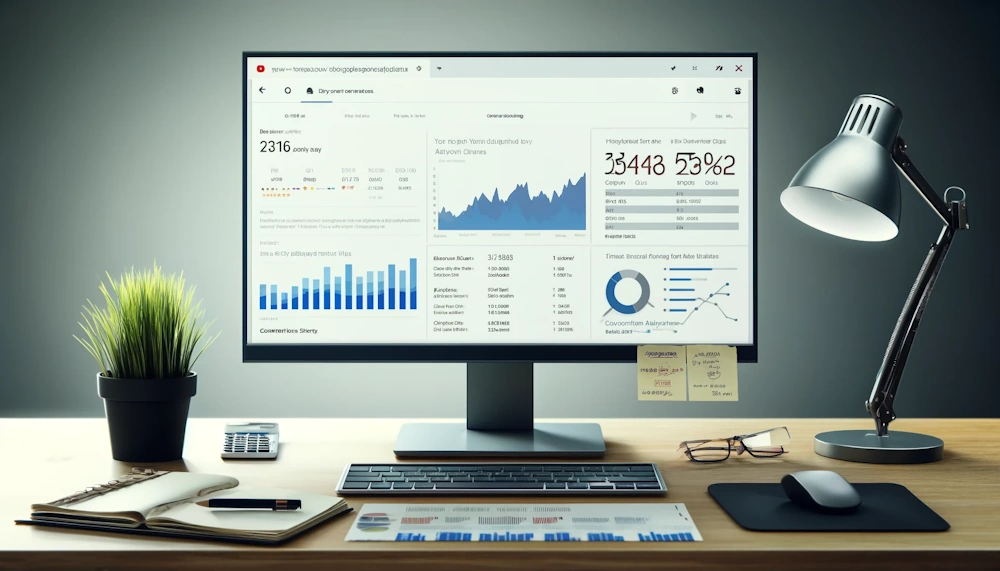Advanced Google Advertising Strategies: Elevate Your Brand From Good to Great

Mastering Google Ads is crucial for any brand wanting to transition from good to great. This article takes a look into sophisticated strategies that can significantly elevate your brand’s visibility and engagement. As a specialist PPC agency, we not only provide insights but also offer our expertise to refine your advertising efforts. Let’s explore how you can enhance your advanced Google advertising strategies to achieve outstanding results.
Key Takeaways
- Utilise advanced Google Ads automation tools to increase efficiency and campaign performance.
- Explore sophisticated keyword strategies to target more specific and relevant audiences.
- Incorporate ad extensions and optimise mobile responsiveness to enhance visibility and user engagement.
- Leverage precise audience targeting and integrate with various marketing channels for a cohesive strategy.
- Analyse performance data rigorously to continually refine and optimise your advertising strategies for maximum ROI.
Advanced Google Advertising Strategies: Harnessing the Power of Google Ads Automation
Utilising Smart Bidding for Optimised Results
Smart Bidding in Google Ads leverages machine learning to optimise your bids for each auction. This automated bidding strategy focuses on maximising conversions and can significantly enhance your campaign performance by adjusting bids in real time based on many signals. These include device, location, time of day, and more, ensuring that your ads are shown to the right audience at the right time.
Setting Up Automated Rules for Efficiency (Advanced Google Advertising Strategies)
Automated rules in Google Ads allow you to manage your campaigns efficiently without constant manual intervention. By setting rules based on specific conditions, such as pausing low-performing ads or adjusting bids during high-traffic periods, you can ensure that your campaigns run optimally with minimal oversight. This not only saves time but also improves campaign effectiveness.
Leveraging AI for Enhanced Campaign Performance
The integration of Artificial Intelligence (AI) in Google Ads is transforming how campaigns are managed. AI analyses historical data and ongoing campaign performance to provide insights and recommendations for improvement. This proactive approach allows for the fine-tuning of campAIgns to better meet business objectives, making AI an indispensable tool in the modern digital marketer’s arsenal.
Advanced Google Advertising Strategies: Exploring Advanced Keyword Strategies
Beyond the Basics: Using Long-Tail Keywords
Long-tail keywords are essential for targeting more specific, niche audiences. They typically have lower competition and can significantly improve the quality of traffic to your website. Incorporating long-tail keywords into your strategy can lead to higher conversion rates as they align closely with user intent.
Keyword Match Types and When to Use Them (Advanced Google Advertising Strategies)
Understanding the different keyword match types—broad, phrase, and exact—allows for better control over who sees your ads. Utilising the right match type can enhance your campaign’s efficiency and help manage your budget effectively. For instance, exact match keywords are crucial when targeting specific queries, while broad match can attract a wider audience.
Negative Keywords and Their Impact on Budget
Negative keywords prevent your ads from showing on irrelevant searches, thus saving your budget and improving campaign focus. Regularly updating your negative keyword list is a vital practice to ensure that your ads are not appearing for unwanted terms. This proactive approach helps in refining ad targeting and enhancing overall ad performance.
Advanced Google Advertising Strategies: Mastering Ad Extensions to Boost Visibility
Types of Ad Extensions and Their Benefits
Ad extensions are a powerful feature in Google Ads that allow you to enhance your ads with additional information, thus increasing the ad’s real estate and visibility on the search results page. Common types include call extensions, location extensions, and site link extensions, each serving a unique purpose to attract specific user actions. Using the right mix of ad extensions can significantly improve your click-through rates.
Customising Ad Extensions for Targeted Impact (Advanced Google Advertising Strategies)
To maximise the effectiveness of ad extensions, it’s crucial to tailor them to the needs of your target audience. For instance, if you’re targeting a local customer base, emphasising location and call extensions would be most beneficial. This customisation ensures that the extensions are not just additional information, but a strategic part of your campaign that engages the specific interests and needs of your audience.
Best Practises for Ad Extension Management
Managing ad extensions effectively involves regular reviews and updates to ensure they remain relevant and impactful. Here are some best practices:
- Regularly update site link descriptions to keep them fresh and relevant.
- Use structured snippets to highlight specific aspects of your products or services.
- Analyse performance data to retire non-performing extensions and test new ones.
Remember: The strategic use of ad extensions can greatly enhance the visibility and effectiveness of your ads, making them a crucial element in your Google Ads strategy.
Advanced Google Advertising Strategies: Leveraging Audience Targeting for Precision Marketing
Understanding Audience Segments in Google Ads
Audience segmentation is crucial for delivering personalised ad experiences. By categorising users based on their behaviours, interests, and demographic details, marketers can tailor their campaigns to resonate deeply with each segment. Effective segmentation enhances engagement and conversion rates, making it a cornerstone of precision marketing.
Advanced Techniques for Audience Targeting (Advanced Google Advertising Strategies)
To truly excel in audience targeting, one must go beyond basic demographics. Incorporating psychographic data—such as values, attitudes, and lifestyles—into your targeting strategy can significantly refine your ad delivery. This approach ensures that your ads are not only seen but are also relevant to the viewers, thereby increasing the likelihood of conversion.
Integrating CRM Data for a Unified Strategy
Integrating Customer Relationship Management (CRM) data with Google Ads allows for a seamless marketing experience. This integration enables the creation of highly targeted ads based on detailed customer profiles and past interactions. By leveraging this rich data, businesses can deliver highly customised ads that are more likely to drive engagement and sales.
- Key Benefits of CRM Integration:
- Enhanced targeting precision
- Improved ad relevance
- Increased conversion rates
By harnessing the power of detailed audience data, marketers can create more effective and efficient campaigns that resonate on a personal level.
Advanced Google Advertising Strategies: Optimising for Mobile – A Necessity in Today’s Market
Creating Mobile-Friendly Ad Campaigns
In today’s digital age, ensuring your Google Ads are optimised for mobile devices is not just beneficial; it’s essential. With the majority of users accessing the internet via smartphones, your campaigns must be designed to be visually appealing and functional on smaller screens. Focus on simplicity and speed to enhance user engagement and conversion rates.
The Importance of Speed and User Experience (Advanced Google Advertising Strategies)
Speed is a critical factor in mobile advertising. A delay of even a few seconds can lead to decreased user satisfaction and increased bounce rates. Implementing AMP (Accelerated Mobile Pages) can significantly improve loading times, providing a smoother experience for mobile users. Remember, a positive user experience translates to better ad performance and, ultimately, higher ROI.
Adapting Strategies for Mobile-First Indexing
With Google’s shift towards mobile-first indexing, it’s imperative to adapt your strategies to prioritise mobile. This involves more than just responsive design; it includes understanding how mobile users interact differently with ads compared to desktop users. Tailoring your content and calls to action to fit mobile usage can lead to more effective campaigns and increased engagement.
By prioritising mobile optimisation in your Google Ads strategies, you are not only improving your current campaign performance but also setting a foundation for future success in the ever-evolving digital landscape.
Advanced Google Advertising Strategies: Utilising Video Ads to Engage and Convert
Crafting Compelling Video Content
Creating engaging video content is essential for capturing the attention of your audience. The key to success lies in understanding what resonates with your viewers and crafting your messages to align with their preferences and needs. Utilise storytelling techniques and high-quality visuals to make your video ads memorable and effective.
Strategic Placement of Video Ads (Advanced Google Advertising Strategies)
The placement of video ads can significantly impact their effectiveness. It’s crucial to place your ads where they will be most visible to your target audience. Consider platforms where your audience spends most of their time, such as YouTube, social media, or relevant websites. Tailoring the placement to match viewer habits increases the likelihood of engagement and conversion.
Measuring the Success of Video Campaigns
To truly understand the impact of your video ads, you must measure their performance meticulously. Key metrics to monitor include view count, engagement rate, and conversion rate. Tools like Google Analytics and Google Ads provide comprehensive data that helps refine strategies and improve ROI. Regular analysis allows for ongoing optimisation, ensuring that your video ads continue to perform at their best.
Advanced Google Advertising Strategies: Navigating the Complexities of Google Shopping Ads
Setting Up and Optimising Shopping Campaigns
Successfully setting up and optimising Google Shopping campaigns requires a meticulous approach. Begin by ensuring your product data is accurate and comprehensive. This includes detailed descriptions, correct categorisation, and high-quality images. Optimise your product titles and descriptions for search relevance and user engagement. Regularly review performance metrics to adjust bids and improve visibility.
Using Product Data for Better Ad Performance (Advanced Google Advertising Strategies)
The quality of your product data directly influences the performance of your Shopping ads. Structured and well-maintained product information ensures higher visibility and conversion rates. Consider implementing a table to track key product attributes and their impact on ad performance:
| Attribute | Impact on Ad Performance |
|---|---|
| Price | High |
| Stock | Medium |
| Rating | High |
Advanced Strategies for Seasonal Campaigns
Seasonal trends significantly affect Shopping ad success. Plan your campaigns well in advance, leveraging historical sales data to forecast demand. Tailor your product offerings and adjust your ad spend based on anticipated seasonal shifts. Utilise strategic discounts and promotions to capture consumer interest during peak shopping periods.
Advanced Google Advertising Strategies: Implementing Effective Remarketing Strategies
Remarketing in Google Ads allows you to reconnect with individuals who have previously interacted with your website or mobile app. It is a powerful tool to increase brand recall and convert window shoppers into buyers. By displaying targeted ads to these past visitors as they browse the web or use apps, you can keep your brand at the forefront of their minds, potentially leading to more conversions.
Basics of Remarketing in Google Ads
Remarketing starts with the creation of a remarketing list that captures the details of visitors based on their engagement with your site. This list is then used to serve tailored ads that are relevant to their initial interaction. For instance, if a visitor abandoned a shopping cart, you can target them with ads that display the exact items they considered, enhancing the chances of completing the purchase.
Customising Remarketing Lists for Specific Audiences (Advanced Google Advertising Strategies)
To maximise the effectiveness of your remarketing campaigns, it’s crucial to segment your audiences meticulously. Tailoring your remarketing lists according to user behaviour, such as frequent visitors or past purchasers, allows for more personalised and effective ad targeting. This strategic segmentation can significantly improve your campaign’s return on investment.
Creative Approaches to Remarketing Ads
Innovative and engaging ad content is key to successful remarketing. Consider using dynamic ads that automatically adjust content and messaging based on the user’s past interactions with your site. This approach not only keeps your ads relevant but also adds a layer of personalisation that can resonate more deeply with the audience. By leveraging creative formats and compelling messaging, you can enhance the impact of your remarketing efforts.
Advanced Google Advertising Strategies: Integrating Google Ads with Other Marketing Channels
Integrating Google Ads into a broader marketing strategy can significantly amplify your brand’s reach and impact. By synchronising your advertising efforts across multiple channels, you can create a cohesive and powerful marketing ecosystem.
The Power of Multi-Channel Marketing
Embracing a multi-channel approach allows for a more robust engagement with potential customers. It ensures that your message is consistent across all platforms, from social media to email campaigns, enhancing the customer journey at every touchpoint. This strategy not only increases visibility but also boosts conversion rates by reaching audiences through their preferred media.
Synchronising Google Ads with Social Media Efforts (Advanced Google Advertising Strategies)
Integrating Google Ads with social media platforms can lead to a more targeted and effective campaign. Utilising data from both channels can help refine your targeting strategies, making your ads more relevant to your audience. This synchronisation can be particularly effective in retargeting, where ads on social media remind users of the products they viewed on your website, thereby increasing the likelihood of conversion.
Leveraging Email Marketing with Google Ads Insights
Using insights from Google Ads to inform your email marketing campaigns can lead to more personalised and effective communications. By analysing the performance data from your ads, you can identify which products or services are most appealing to your audience and tailor your emails to match these preferences. This targeted approach helps in nurturing leads and converting them into loyal customers.
Advanced Google Advertising Strategies: Analysing and Utilising Ad Performance Data
Key Metrics to Monitor for Campaign Success
To truly understand the effectiveness of your Google Ads campaigns, it’s crucial to monitor specific key metrics. These include click-through rates (CTR), conversion rates, cost per conversion, and return on ad spend (ROAS). By keeping a close eye on these indicators, you can gauge the health of your campaigns and make informed decisions to enhance performance.
Tools for Tracking and Analysing Performance (Advanced Google Advertising Strategies)
A variety of tools are available to help you track and analyse the performance of your Google Ads. Google Analytics is a powerful companion that provides deep insights into user behaviour and ad effectiveness. Additionally, third-party tools like SEMrush and Ahrefs offer advanced analytics and competitive intelligence that can further refine your strategy.
Turning Data Insights into Actionable Strategies
The real power of data lies in its ability to drive strategic decisions. Transforming raw data into actionable insights is essential for optimising your campaigns. Regularly review your performance data to identify trends, spot potential issues, and adjust your strategies accordingly. This proactive approach ensures that your Google Ads are always aligned with your business objectives and market dynamics.
Advanced Google Advertising Strategies: Advanced Bidding Strategies for Maximum ROI
Exploring Cost-Per-Acquisition (CPA) Bidding
Cost-Per-Acquisition (CPA) bidding is a pivotal strategy for advertisers aiming to optimise their return on investment. By focusing on the cost directly linked to an acquisition, marketers can more effectively control their ad spend, ensuring that they are investing in ads that convert. This approach is particularly beneficial for businesses with specific conversion goals, such as sign-ups or purchases.
Utilising Return on Ad Spend (ROAS) Metrics (Advanced Google Advertising Strategies)
Return on Ad Spend (ROAS) is a critical metric for assessing the effectiveness of your advertising campaigns. It helps you understand the direct financial return from your Google Ads spend. A well-optimised ROAS strategy ensures that every penny spent is accounted for and contributes to your business objectives. Here’s a simple breakdown of how to calculate ROAS:
| Metric | Formula |
|---|---|
| Revenue | Total Revenue Generated by Ads |
| Ad Spend | Total Spent on Ads |
| ROAS | Revenue / Ad Spend |
When to Adjust Bidding for Optimal Performance
Adjusting your bids can be crucial for maintaining campaign efficiency and effectiveness. It’s important to regularly review performance data and make adjustments to your bids based on several factors, including market changes, competitive landscape, and campaign objectives. Here are a few scenarios when you might consider adjusting your bids:
- Significant changes in market conditions
- Introduction of new competitors
- Shifts in your campaign goals
- Seasonal fluctuations in demand
Advanced Google Advertising Strategies: The Future of Google Advertising – Trends to Watch
Emerging Technologies in Digital Advertising
The advertising landscape is continuously evolving with the introduction of cutting-edge technologies. Augmented reality (AR) and virtual reality (VR) are setting new benchmarks in how brands can interact with consumers. These technologies create immersive ad experiences that can significantly enhance user engagement and brand recall.
Predictive Analytics and Its Role in Future Campaigns (Advanced Google Advertising Strategies)
Predictive analytics is becoming a cornerstone in crafting more effective and targeted advertising strategies. By analysing past consumer behaviour and other data points, marketers can anticipate future trends and consumer needs, allowing for more precise ad placements and timing.
Adapting to Changes in Consumer Behaviour
As consumer preferences shift, so must advertising strategies. The rapid adoption of mobile devices and increasing concerns about privacy are influencing how and where ads are displayed. Advertisers need to stay agile, adapting their strategies to meet the ever-changing demands of the market. Emphasising privacy-friendly practices will be crucial in maintaining consumer trust and compliance with regulatory standards.
As the digital landscape evolves, staying ahead in Google advertising is crucial for any business. In our latest article, ‘The Future of Google Advertising: Trends to Watch‘, we delve into the emerging trends that are shaping the future of online advertising. Don’t miss out on gaining a competitive edge. Visit our website to read the full article and discover how our expert insights can help you maximise your advertising efforts.
Conclusion
In conclusion, mastering advanced Google advertising strategies is not just about enhancing visibility; it’s about strategically positioning your brand to thrive in a competitive digital landscape. By embracing the techniques discussed, from refined targeting to sophisticated use of data analytics, you can transform your approach from good to great. Remember, the journey to digital excellence is continuous, and staying ahead requires not only adopting new strategies but also constantly refining them. For tailored advice and expert management of your Google Ads campaigns, consider partnering with a specialist PPC agency that can help elevate your brand to its fullest potential.
Frequently Asked Questions
What are the key benefits of using Google Ads automation?
Google Ads automation streamlines campaign management, enhances targeting precision, and improves bid strategies, ultimately increasing efficiency and campaign performance.
How can long-tail keywords impact my Google Ads campaigns?
Long-tail keywords target more specific queries, which can lead to higher conversion rates and lower competition, making them cost-effective.
What are ad extensions and how do they improve visibility?
Ad extensions expand your advertisements with additional information, such as contact details or links to specific pages, thereby increasing the ad’s visibility and click-through rates.
Why is audience targeting crucial in Google Ads?
Audience targeting allows you to segment and reach specific user groups based on their behaviours, interests, and demographics, leading to more personalised and effective campaigns.
What are the advantages of mobile-optimised Google Ads?
Mobile-optimised ads enhance user experience on mobile devices, improve ad performance, and are crucial as mobile searches continue to rise.
How do video ads enhance Google Ads campaigns?
Video ads can significantly increase engagement, convey complex messages succinctly, and improve conversion rates through visual and auditory stimulation.
What strategies enhance Google Shopping Ads?
Optimising product data, using high-quality images, and employing strategic bidding tactics can improve visibility and sales in Google Shopping campaigns.
What is the importance of integrating Google Ads with other marketing channels?
Integration allows for a cohesive marketing strategy that amplifies reach, enhances data collection, and improves overall campaign effectiveness.
Author
Search Blog
Free PPC Audit
Subscribe to our Newsletter
The Voices of Our Success: Your Words, Our Pride
Don't just take our word for it. With over 100+ five-star reviews, we let our work-and our satisfied clients-speak for us.
"We have been working with PPC Geeks for around 6 months and have found Mark and the team to be very impressive. Having worked with a few companies in this and similar sectors, I rate PPC Geeks as the strongest I have come across. They have taken time to understand our business, our market and competitors and supported us to devise a strategy to generate business. I value the expertise Mark and his team provide and trust them to make the best recommendations for the long-term."
~ Just Go, Alasdair Anderson




